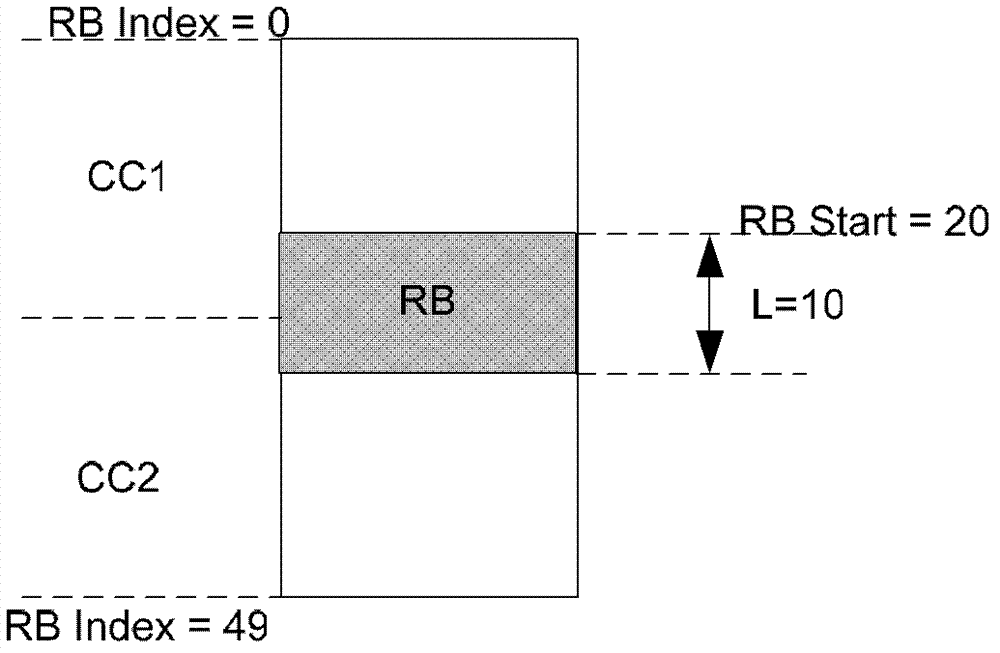Method and device of multi-carrier scheduling
A multi-carrier and carrier technology, which is applied in the directions of multiple use of transmission paths, separation devices of transmission paths, digital transmission systems, etc., can solve problems such as affecting data transmission delay and affecting normal data scheduling.
- Summary
- Abstract
- Description
- Claims
- Application Information
AI Technical Summary
Problems solved by technology
Method used
Image
Examples
Embodiment 1
[0042] The multi-carrier scheduling configuration message sent by the eNB to the UE indicates that the UE can be scheduled by a PDCCH command to the UE to send and receive data. The number of the carrier where the PDCCH commands of multiple carriers are located. The resource block coding method is that each carrier is coded sequentially. For the convenience of description, the carrier that the above-mentioned eNB schedules to the UE for data transmission and reception through the PDCCH command is called the first carrier, and the carrier where the PDCCH commands that schedule the multiple first carriers are located is called the second carrier. The following embodiments continue to use the same terminology.
[0043] Thereafter, the eNB sends a PDCCH order to the UE on the second carrier. In the PDCCH order, the indication information of the resource blocks that the UE can use includes the resource block start code and the number of resource blocks, so that the UE can use the ...
Embodiment 2
[0047] As a variant of Embodiment 1, the multi-carrier scheduling configuration message sent by the eNB to the UE indicates that the encoding of the multiple first carriers scheduled by the UE is continuous, and the resource block encoding mode of the first carrier is unified for the first carrier sequential encoding.
[0048] Afterwards, the eNB sends a PDCCH order to the UE on the second carrier, and the indication information of the resource blocks that the UE can use in the PDCCH order includes the start code of the resource block and the number of resource blocks, so that the UE can use the resource block on the first carrier. The resource block starts encoding and resources defined by the resource block number.
[0049] For example, the first carrier is carrier 1 and carrier 2, the second carrier is carrier 3, and the codes of RBs on carriers 1 and 2 are RB Index=0~49, that is, RB Index=0~24 on carrier 1 and RB index on carrier 2 RB Index=25~49; the PDCCH command indica...
Embodiment 3
[0052] The multi-carrier scheduling configuration message sent by the eNB to the UE indicates the number of multiple first carriers scheduled by the UE, where the resource block encoding method of the first carrier is based on the second carrier that sends the PDCCH command, and is paired according to the carrier number The carriers indicated by the number of the first carriers are sequentially coded.
[0053] According to the embodiment of the present invention, in specific implementation, all carriers configured for the UE may be scheduled by default, and the number of first carriers is equal to the number of all carriers configured for the UE.
[0054] Thereafter, the eNB sends a PDCCH order to the UE on the second carrier, and the indication information of the resource blocks available to the UE in the PDCCH order includes the resource block start code and the number of resource blocks, so that the UE can use the first resources on a carrier defined by said resource block ...
PUM
 Login to View More
Login to View More Abstract
Description
Claims
Application Information
 Login to View More
Login to View More - R&D
- Intellectual Property
- Life Sciences
- Materials
- Tech Scout
- Unparalleled Data Quality
- Higher Quality Content
- 60% Fewer Hallucinations
Browse by: Latest US Patents, China's latest patents, Technical Efficacy Thesaurus, Application Domain, Technology Topic, Popular Technical Reports.
© 2025 PatSnap. All rights reserved.Legal|Privacy policy|Modern Slavery Act Transparency Statement|Sitemap|About US| Contact US: help@patsnap.com



